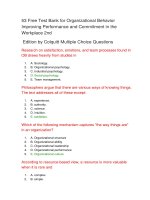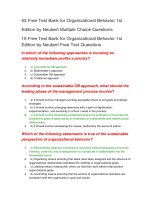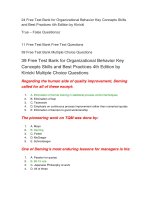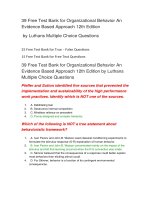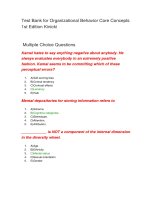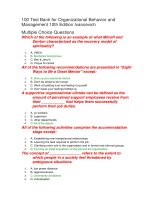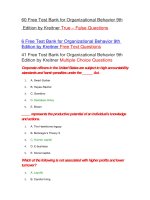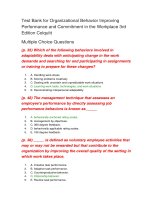74 test bank for organizational behavior key concepts skills and best practices 4th edition
Bạn đang xem bản rút gọn của tài liệu. Xem và tải ngay bản đầy đủ của tài liệu tại đây (99.26 KB, 16 trang )
24 Free Test Bank for Organizational Behavior Key Concepts Skills
and Best Practices 4th Edition by Kinicki
True – False Questions ư
11 Free Test Bank Free Text Questions
39 Free Test Bank Multiple Choice Questions
39 Free Test Bank for Organizational Behavior Key
Concepts Skills and Best Practices 4th Edition by
Kinicki Multiple Choice Questions
Regarding the human side of quality improvement, Deming called for all of
these except:
1.
A. Elimination of formal training in statistical process control techniques
2.
B. Elimination of fear
3.
C. Teamwork
4.
D. Emphasis on continuous process improvement rather than numerical quotas
5.
E. Elimination of barriers to good workmanship
The pioneering work on TQM was done by:
1.
A. Mayo
2.
B. Deming
3.
C. Follett
4.
D. McGregor
5.
E. Schronberger
One of Deming's most enduring lessons for managers is his:
1.
A. Passion for quotas
2.
B. 85-15 rule
3.
C. Japanese Philosophy at work
4.
D. All of these
Deming believed that when thing go wrong, about what percent of the time
is the individual employee at fault?
1.
A. 85 percent
2.
B. 40 percent
3.
C. 15 percent
4.
D. 60 percent
5.
E. 100 percent
Which of these is a component of productivity in the 4-P cycle of
continuous improvement?
1.
A. System flexibility
2.
B. Organizational learning
3.
C. Reduced waste and rework
4.
D. Technological advancement
5.
E. Readiness to change and adapt
Which of these is a Theory Y assumption about people at work?
1.
A. The typical employee can learn to accept and seek responsibility.
2.
B. Most people dislike work.
3.
C. Most people actually prefer to be directed.
4.
D. People require close direction when they are working.
5.
E. People are interested only in security.
James has always believed that his employees are lazy and they dislike
work. He is afraid that if he does not provide close direction and
supervision, they will goof off. James can be described as a:
1.
A. Theory Y manager
2.
B. Hawthorne manager
3.
C. Theory Z manager
4.
D. Human relations manager
5.
E. Theory X manager
_________ is the productive potential of an individual's knowledge and
actions.
1.
A. Social capital
2.
B. Skills
3.
C. Motivation
4.
D. Teamwork
5.
E. Human capital
The nature of interpersonal relationships for 21st century managers
should be ___________.
1.
A. Win-lose
2.
B. Competitive
3.
C. Judicial
4.
D. Neutral
5.
E. Cooperative
Which of these is NOT human capital?
1.
A. Knowledge
2.
B. Skills
3.
C. Motivation
4.
D. Teamwork
5.
E. The productive potential of an individual's knowledge and actions
Managers of the 21st century will engage in all of these roles except:
1.
A. Sponsor
2.
B. Controller
3.
C. Teacher
4.
D. Facilitator
5.
E. Advocate
As a production manager of Great Golf Products (GGP), Hansa believes
that her employees are capable of self-direction and self-control. She also
believes that they are committed to GGP's objectives since they are
rewarded for doing so. Hansa can be described as a:
1.
A. Theory X manager
2.
B. Theory Z manager
3.
C. Futuristic manager
4.
D. Theory Y manager
5.
E. Hawthorne manager
Luthans' CHOSE model of key POB Dimensions includes all of these
behaviors except:
1.
A. Pessimism
2.
B. Emotional intelligence
3.
C. Hope
4.
D. Confidence (self-efficacy)
5.
E. Subjective well-being
According to Wilson's research, if Monica wants to be an effective
manager, she should focus on developing _____________.
1.
A. Vertical communication
2.
B. A monocultural orientation
3.
C. Develop narrow specialty
4.
D. Empowerment and delegation
5.
E. Competitive interpersonal relationships
Which of these is NOT identified as a common TQM principle?
1.
A. Do it right the first time to eliminate costly rework.
2.
B. Listen to and learn from customers and employees.
3.
C. Focus on numerical quotas to make productivity gains.
4.
D. Build teamwork, trust, and mutual respect.
5.
E. Make continuous improvement on everyday matter.
Which of these is an interdisciplinary field dedicated to better
understanding and managing people at work?
1.
A. Anthropology
2.
B. Sociology
3.
C. Organizational Behavior
4.
D. Psychology
5.
E. Economics
According to the Wilson managerial skills research, dealing effectively
with _____ is what management is all about.
1.
A. People
2.
B. Products
3.
C. Processes
4.
D. Productivity
5.
E. Skills
In today's workplace, ______ are becoming the primary building block of
organizations.
1.
A. Teams
2.
B. Suppliers
3.
C. Contingent employees
4.
D. Individuals
5.
E. Middle managers
All but one of these factors was responsible for high output in the relay
assembly test room experiences of the Hawthorne findings. Which one?
1.
A. Money
2.
B. Fear of unemployment during the Great Depression
3.
C. Managerial discipline
4.
D. Supportive supervision
5.
E. High-quality raw materials
Which of these is a Theory X assumption about people at work?
1.
A. Work is a natural activity.
2.
B. People are capable of self-direction if they are committed to objectives.
3.
C. The typical employee can learn to accept and seek responsibility.
4.
5.
D. People generally become committed to objectives if they are rewarded for
doing so.
E. Most people prefer to be directed.
According to Pfeffer's research, successful companies employed all of
these people-centered practices except:
1.
A. Power to the people
2.
B. Careful hiring
3.
C. Job security
4.
D. Emphasis on status
5.
E. Trust building
Which approach calls for using management concepts and techniques in
a situationally appropriate manner?
1.
A. One best way approach
2.
B. Human relations approach
3.
C. Theory X management approach
4.
D. Contingency approach
5.
E. Theory Y management approach
Future managers will tend to use _________ as criterion for determining
compensation.
1.
A. Status
2.
B. Time
3.
C. Results
4.
D. Effort
5.
E. Rank
In a recent survey of chief financial officers, meeting customer demands
placed second only to _________ as the companies' biggest challenge.
1.
A. Profitability
2.
B. Stock price
3.
C. Fuel prices
4.
D. Finding skilled staff
5.
E. Legal restrictions
An e-corporation uses the internet to:
1.
A. Buy supplies
2.
B. Sell its products
3.
C. Build partnerships with outsiders
4.
D. Only a and b, but not c
5.
E. All of the above
Which of these refers to using the Internet to facilitate every aspect of
running a business?
1.
A. E-mail
2.
B. E-commerce
3.
C. Networking
4.
D. E-business
5.
E. TQM
Clark Wilson's managerial skills profile includes all of these except:
1.
A. Control details
2.
B. Provides feedback
3.
C. Applies reasonable pressure for good accomplishment
4.
D. Facilitates work
5.
E. Possesses monocultural orientation
All of these are new directions for OB except:
1.
A. Globalization
2.
B. Human capital
3.
C. Positive organizational behavior
4.
D. Impacts of the Internet revolution
5.
E. Social capital
____ refers to a organizational culture dedicated to training, continuous
improvement, and customer satisfaction.
1.
A. Management by objectives
2.
B. Theory X management
3.
C. Total quality management
4.
D. Theory Y management
5.
E. Job design
_____ is the process of working with and through others to achieve
organizational objectives in an efficient and ethical manner.
1.
A. Organizational manner
2.
B. Sociology
3.
C. Organization theory
4.
D. Management
5.
E. Anthropology
Which of these is not a landmark in the evolution of understanding and
managing people?
1.
A. The human relations movement
2.
B. The total quality management movement
3.
C. The glass ceiling movement
4.
D. The contingency approach to management
5.
E. All of these are landmarks the evolution of understanding and managing people
Jeremy, CEO of JNJ Computers, wants to build his company around the
people-centered practices. Based on Pfeffer's research, which of these
practice(s) should he adopt?
1.
A. Less emphasis on status
2.
B. Generous pay for performance
3.
C. Power to the people
4.
D. Job security
5.
E. Emphasize short-term profitability
The Wilson managerial skills research yields which of these following
lessons?
1.
A. Dealing effectively with productivity is what management is all about.
2.
B. Effective female and male managers do not have significantly different skills
profiles.
3.
C. Managers with high skill mastery tend to have poorer subunit performance than
managers with low skill mastery.
4.
D. Dealing effectively with products is what management is all about.
5.
E. All of these.
The 4-P cycle of continuous improvement includes all of these except:
1.
A. People
2.
B. Promotion
3.
C. Products
4.
D. Productivity
5.
E. Processes
Which of the following refers to the productive potential of strong,
trusting, and cooperative relationships?
1.
A. Social capital
2.
B. Skills
3.
C. Motivation
4.
D. Teamwork
5.
E. Human capital
24 Free Test Bank for Organizational Behavior Key
Concepts Skills and Best Practices 4th Edition by
Kinicki True - False Questions
E-business has significant implications for management, but not for
organizational behavior.
1.
True
2.
False
According to Clark Wilson's research, effective managers recognize good
performance with rewards and positive reinforcement.
1.
True
2.
False
Management is the process of working with and through others to achieve
organizational objectives in an efficient and ethical manner.
1.
True
2.
False
One of Deming's most enduring lessons for managers is his 85-15 rule.
1.
True
2.
False
According to the Wilson approach, the effective manager's profile is a
result of skill mastery.
1.
True
2.
False
Theory Y assumptions, according to McGregor, are pessimistic and
negative and representative of how managers traditionally view
employees.
1.
True
2.
False
Mayo advised managers to attend to employees' emotional needs in her
1933 classic, The Human Problems of an Industrial Civilization.
1.
True
2.
False
For future managers, ethical considerations will be a forethought rather
than an afterthought.
1.
True
2.
False
POB stands for Permanent Organizational Behaviors.
1.
True
2.
False
Many of the Hawthorne plant findings have turned out to be more myth
than fact.
1.
True
2.
False
An e-corporation is one that relies primarily on the internet to buy and sell
things.
1.
True
2.
False
By definition, organizational behavior is research-oriented, and not
application-oriented.
1.
True
2.
False
E-business refers to using the Internet to facilitate every aspect of running
a business.
1.
True
2.
False
The 4-P cycle of continuous improvement focuses on product, price,
promotion and people.
1.
True
2.
False
According to Pfeffer's research, one of the people-centered practices in
successful companies is to emphasize short-term profits.
1.
True
2.
False
TQM is customer-centered and manager-driven.
1.
True
2.
False
The contingency approach discourages managers from viewing OB within
a situational context.
1.
True
2.
False
Three basic levels of analysis in OB are group, team, and organization.
1.
True
2.
False
According to the Wilson managerial skill research, effective male and
female managers have a significantly different skill profile.
1.
True
2.
False
OB is a horizontal discipline that cuts across virtually every job category,
business function, and professional specially.
1.
True
2.
False
In today's workplace, individuals are becoming the primary building block
of organizations.
1.
True
2.
False
Observational studies by Mintzberg and others have found the typical
manager's day to be a fragmented collection of brief episodes.
1.
True
2.
False
Human and social capital cannot be built; they are inherent qualities.
1.
True
2.
False
The field of OB is in static and final form.
1.
True
2.
False
11 Free Test Bank for Organizational Behavior Key
Concepts Skills and Best Practices 4th Edition by
Kinicki Free Text Questions
Contrast McGregor's Theory X and Theory Y assumptions about
employees.
Answer Given
See Table 1-2 for McGregor's Theory X and Theory Y assumptions about people
at work.
Define and contrast human and social capital.
Answer Given
Human capital is the productive potential of an individual's knowledge and actions.
Social capital is productive potential resulting from strong relationships, goodwill,
trust, and cooperative effort. Figure 1-2 contrasts the two.
Define POB, and explain Luthans' CHOSE Model. Why should managers
pay attention to this topic?
Answer Given
POB (positive organizational behavior) is the study and improvement of
employees' positive attributes and capabilities. The CHOSE model identifies five
key dimensions of POB: confidence/self-efficacy, hope, optimism, subjective wellbeing, and emotional intelligence.
Briefly describe the 4-P mode cycle of continuous improvement.
Answer Given
The 4-P mode focuses on people, products, processes, and productivity. See
figure 1-1 for details.
What is e-business? What implications does e-business have for
managers in working with their subordinates?
Answer Given
E-business is using the Internet to facilitate every aspect of running a business.
Implications for managers include the ability to link to the Internet with small,
portable devices; the ability to make quicker and better decisions because of
speedy access to vital information; the use of virtual teams, virtual organizations,
email, and e-learning.
What is the "contingency approach to management"? What does it tell
managers about what they should do?
Answer Given
The contingency approach calls for using management concepts and techniques
in a situationally appropriate manner, instead of trying to rely on "one best way."
Identify at least five skills for managers and three useful lessons from the
Wilson managerial skills research. Wilson's managerial skills profile
focuses on eleven observable categories of managerial behavior.
Answer Given
See the box "Skills and Best Practices: The Effective Manager's Skill Profile" for
these skills. The Wilson research yields three useful lessons: 1) Dealing effectively
with people is what management is all about; 2) Managers with high skills mastery
tend to have better sub unit performance and employee morale than managers
with low skills mastery; 3) Effective female and male managers do not have
significantly different skill profiles.
Describe Deming's principles for the human side of quality improvement.
Answer Given
Deming called for: helpful leadership, elimination of fear, emphasis on continuous
process improvements, teamwork, and elimination of barriers to good
workmanship.
Identify the four common TQM principles.
Answer Given
1. Do it right the first time to eliminate costly rework; Listen to and learn from
customers and employees; Make continuous improvement an everyday matter;
Build teamwork, trust, and mutual respect.
Briefly describe any two of the new directions in OB and how they affect
managers.
Answer Given
Three general new directions for OB are: human and social capital, positive
organizational behavior, and impacts of the Internet revolution.
Describe the findings of Pfeffer's research about the importance of people
in organizations. What do these findings say about how managers should
manage?
Answer Given
The seven people-centered practices that Pfeffer identified are: job security,
careful hiring, power to the people, generous pay for performance, lots of training,
less emphasis on status, and trust building.


